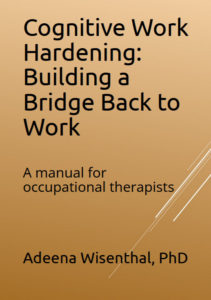Almost three years into the Covid-19 pandemic and we are still feeling its impact. Life has returned to normal to some extent but we are not back to pre-pandemic times. Vaccines are still being distributed with health professionals urging people to get their shots. Hospitals are facing staff shortages while handling admissions and ill patients. Masks are no longer being mandated; however, we are being urged to wear masks indoors in public places. Many employees are still working from home with some movement to hybrid work situations where people work some days at home and other days in the workplace. Covid-19 still has its grip on us.
We have all had to change our ways in response to Covid. We have had to pivot; we have had to accommodate; we have had to adjust to change. Employers have made changes, stores/restaurants have made changes; healthcare providers have made changes. I, as a healthcare provider, have adapted my cognitive work hardening (CWH) program for virtual delivery.
Two weeks after Covid-19 gained pandemic status and we were under lockdown with directives for minimal social interaction, I made changes to my CWH program so that it could be offered virtually to clients. The same principles underlying CWH were utilized; the same return-to-work focus was adopted; the same focus on function, work tolerance/stamina, and work ability were addressed. The difference was that now the return-to-work focus was geared towards clients preparing for returning to work in a virtual, on-line milieu. Clients needed to ensure that they had a work setup in their homes that they could use once they were ‘back at work’ but working from home. Clients had to balance work hours with family needs while working from home and setting boundaries for work time versus family time. Clients needed to get used to virtual meetings, online discussions, and online work output.
Cognitive work hardening once again was in a unique position for return-to-work preparation with its new focus on working from home. My doctoral research into CWH confirmed the relevance and importance of the CWH environment simulating the work setting. Prior to Covid, the simulated work environment where I had been offering this intervention for 20+ years approximated the work setting. With the onset of Covid, the virtual CWH environment now approximates the work setting since the majority of clients are indeed retuning to work within their homes. The unique work focus of CWH is maintained in a virtual capacity owing to its now well matched virtual ‘work setting’ and inclusion of online exchanges and work outputs.
As an occupational therapist, I am client centred. My training and experience has enabled me to address client needs and to adapt to clients’ needs. As an occupational therapy treatment intervention, CWH continues to adapt to what the client needs while maintaining its underlying therapeutic principles. We continue to have a treatment intervention that is occupation focused and work oriented. We continue to have a treatment intervention that is unique and pivotal for return-to-work preparation in a sea of treatments that are available to clients.
Training in CWH is available for occupational therapists. A Foundational Module offers an introduction into this intervention and is a pre-requisite for the four Essential Modules which are designed to give occupational therapists in-depth training and equip them with tools/resources needed to provide the intervention. If you are interested in training, complete the online form at https://cwhconnect.com/contact/.

Adeena Wisenthal
Adeena Wisenthal, PhD, MEd, OT Reg. (Ont.)
Pioneer & developer of CWH since 2000







